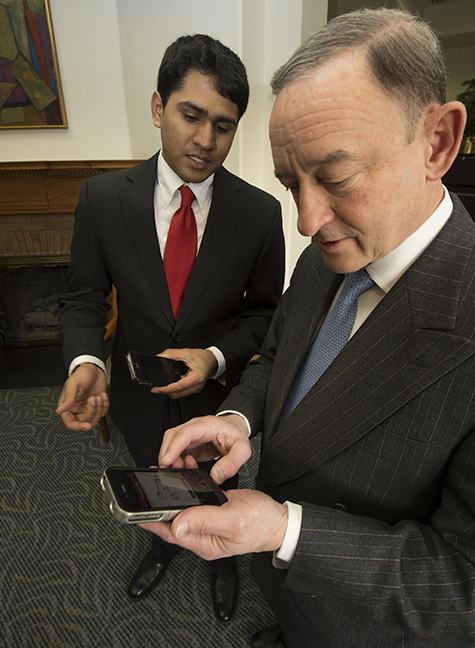
An engineering undergraduate student at Washington University in St. Louis helped create and launch a mobile app that helps students track the campus circulator shuttle.
Vinoo Ganesh, a senior majoring in computer science in the School of Engineering & Applied Science, developed the real-time tracking app, titled “WUSTL Circulator.” The app also shows the circulator’s route and stopping points along with a full schedule that students can browse.
Ganesh developed the application in collaboration with staff from WUSTL’s Parking and Transportation Services and Information Services & Technology.
Ganesh says he took a class on building apps for iPhones and was looking for a way to translate that knowledge into a real-world project. Several friends on campus suggested that knowing when the circulator shuttle will arrive would be a big help.
“The reason I did this is a service to the Wash U students,” he says. “All the administrators got completely behind the effort.”
John Bailey, assistant director of Student Technology Services in IS&T, coordinated the effort and worked closely with Ganesh on the project.
“Vinoo’s idea and prototype app were fantastic,” Bailey says, adding that some additional work was necessary.
The university needed to purchase and install GPS units on the shuttles, set up a server application to feed location data to the app and extensively test it, he says.
Parking and Transportation provided funding for the project, which allowed the university to purchase the necessary GPS units and associated data plans. IS&T provided the server infrastructure to drive the app.
Oliver Jones, a graduate engineering student and a student staff member in Student Technology Services, was instrumental in developing the server mechanisms that collect GPS data and feed it to the app.
As with other student-developed university mobile apps, Ganesh partnered with IS&T during the publication process. IS&T has established guidelines and procedures for reviewing and publishing student-developed apps and already has helped publish 11 apps that were developed in part, or in whole, by students, Bailey says.
The circulator app for iPhones, iPads and iPod touch devices went live on Jan. 23 and is available for free through the iOS app store. An Android version also is in the works and could be ready in coming weeks. Jones is working on that project as well.
As an indication of the app’s demand and popularity, Apple’s stat tracking tool indicated the WUSTL Circulator app had 1,102 downloads on its first day of availability – three to four times the typical number for the first day of a new WUSTL app, Bailey says. By now, it has been downloaded more than 2,300 times, he says.
Ganesh says it’s great to add publishing an app to his résumé, but he also hopes to encourage other student developers to pursue their ideas, saying the university’s support was instrumental in helping his project succeed.
Parking and Transportation hopes the WUSTL Circulator app encourages more people to use the shuttle and improves the experience for regular student riders.